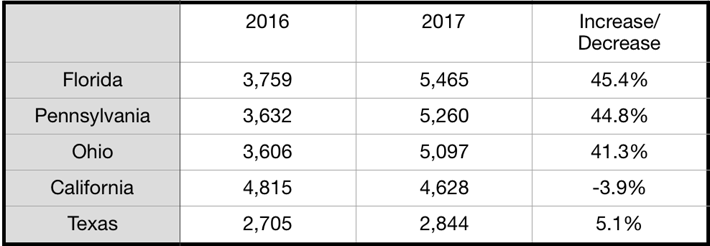Why NOW Is the Most Dangerous Time in History to be Addicted to Opioids
It’s a very easy one-word answer: FENTANYL. Fentanyl as a painkiller is not new but as an illicit drug pervading the American drug market, it is a threat that’s only a few years old. And a deadly, deadly threat it is, too.
On this blog, we have talked about fentanyl in several articles. We’re going to continue talking about fentanyl when there is important information available about it because it has become the most deadly drug in history.
Why an update at this time? On December 13, 2017, the Institute of Justice presented updated information to forensic specialists around the country in a webinar titled Collaboration in the Fight Against Fentanyl. At this time, a collaboration between all the agencies and organizations fighting drug abuse is essential because of the skyrocketing number of deaths from this drug.
Here’s a few vital facts from this webinar.
- Fentanyl deaths have increased 540% in the last three years since illicitly-manufactured fentanyl hit the market in a big way
- Prior to 2013, nearly all of the fentanyl on the illicit market was diverted from medical supplies
- Now the primary source of this illicit fentanyl is China
- The drug is shipped from China to the U.S. directly or it comes in through Canada or Mexico
It might only take one graph to make the threat posed by fentanyl excruciatingly clear. This one.

What Is Fentanyl and What Are Fentanyl Analogues?
When manufactured for medical use, fentanyl is a synthetic opioid painkiller that’s 100 times more powerful than morphine. It’s mostly used for end-of-life or cancer pain because of its addictiveness. But now, illicit labs overseas are manufacturing fentanyl and similar drugs and selling them through the internet or shipping them to drug traffickers.
There are dozens of forms of this drug found in the U.S. and other countries. Just tweaking the fentanyl molecule slightly changes it into a different form of the drug and sometimes those new drugs are not yet illegal. These modified drugs are called fentanyl analogues. Here are some of the kinds of fentanyl that have been found in the U.S. and other countries.
- Fentanyl
- 3-Methylfentanyl
- 3-Methylthiofentanyl
- Acetylfentanyl
- Acetyl-α-methylfentanyl
- Acrylfentanyl
- Alfentanil
- Carfentanil
- 2-Furanylfentanyl
- p-Fluorofentanyl
- Remifentanil
- Sufentanil
- Thiofentanyl

Federal and state legislative bodies have had difficulty keeping up with the lengthening list of fentanyl analogues.
In some states, each new fentanyl analogue must be added to their list of outlawed drugs. In other states, being chemically similar to fentanyl is enough for seizure and prosecution. Any lag in adding a new form of fentanyl to the list of illegal drugs means that the analogue may be legal for a while in some states.
One of these analogues, carfentanil, is 10,000 times stronger than morphine. You can compare the fatal doses of heroin, carfentanil and fentanyl in these photos.
Which States Are Taking the Biggest Hit from Drug-Related Deaths?
Talking about drug-related deaths is rather like talking about a hurricane passing through the U.S. Some states are catastrophically affected and others are spared. The Centers for Disease Control and Prevention tracks the numbers of drug-related deaths and breaks them out by states, revealing which states took the most major hits from overdose deaths.
These numbers compare the number of deaths that occurred in the 12-month period ending in May 2016 with the 12-month period ending in May 2017.

These figures don’t show how many of these deaths can be attributed to fentanyl. Taking into consideration the chart above and the fact that fentanyl deaths shot up 540% in three years, it’s a safe bet that fentanyl is involved in thousands of these deaths and the lion’s share of these increases.
What Is the Solution?
Only a complete collaboration of all anti-drug efforts can ensure these drug-related deaths top out and start declining. Every sector of our society must encourage those who have not started using drugs yet to stay sober and must support the addicted as they work their way back to sobriety. From parents to schools, from hospitals to jails, from police to drug enforcement agents, we must work together to save these lives.
Parents may not realize how vital they are in this fight. If every parent can educate his or her children on the life-threatening dangers of drug abuse, they can prevent these youth from ever starting to use drugs. This alone would start the numbers declining as these children become adults. Here are some resources to help parents.
- A parent’s pledge to keep youth drug-free
- The single most important way to help your kids stay drug-free
- More parental drug prevention needed
- What signs of drug use should parents look for?
Families struggling with the addiction of a loved one may beg in vain for the person to enter a drug rehab. The clutch of addiction is so strong that their loved one will reject every offer of help. It is possible to appeal to an addicted loved one in a way that sparks his (or her) willingness to get sober. Here are some resources to help families.
- What is an intervention?
- Supporting an opioid addict without enabling
- 14 rules you must never break when dealing with addiction
- Do’s and Don’ts for dealing with addiction
If you are looking for help for an addicted loved one, please call us. We have been the choice for recovery for tens of thousands of people. We can help. Call us at (877)-782-7409.


 ®
®